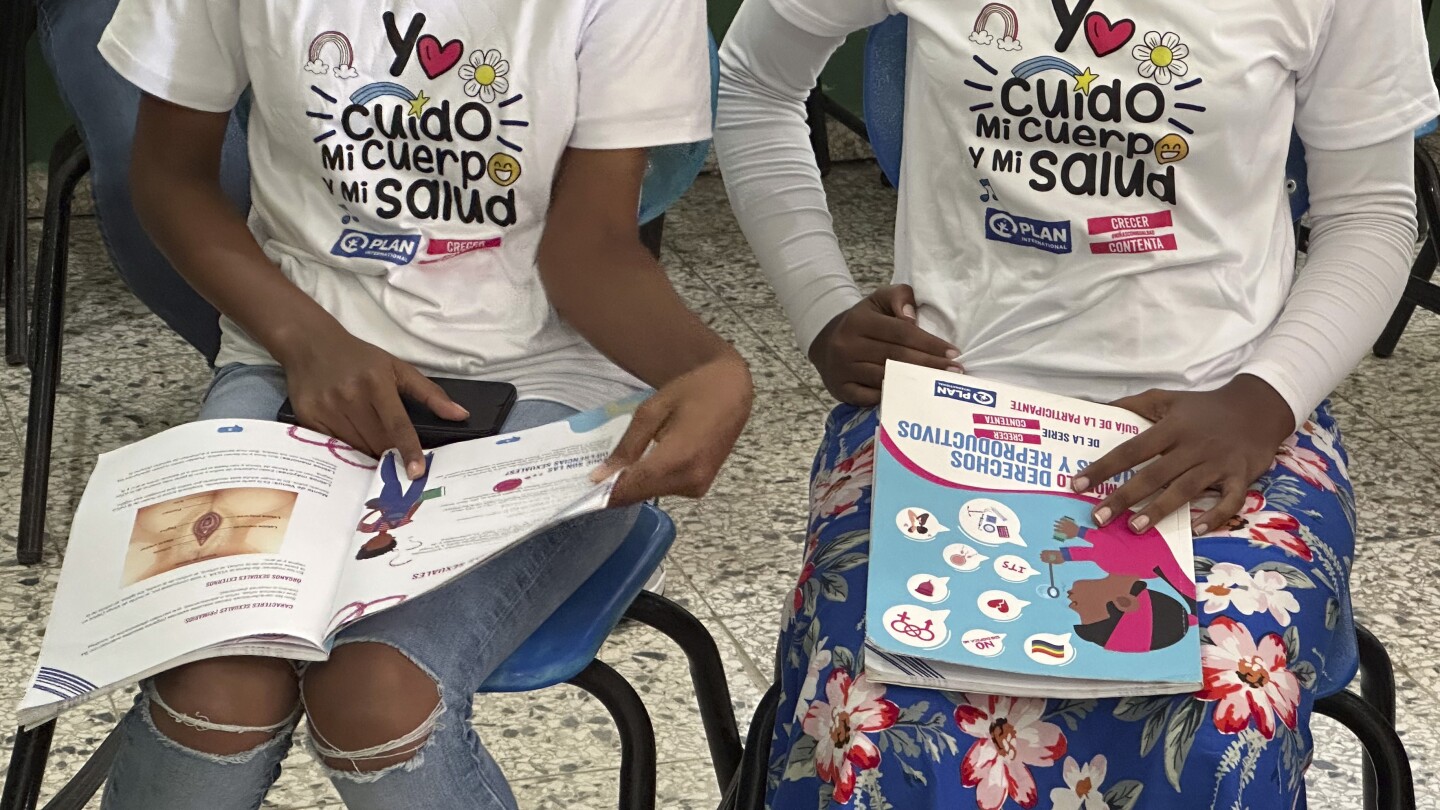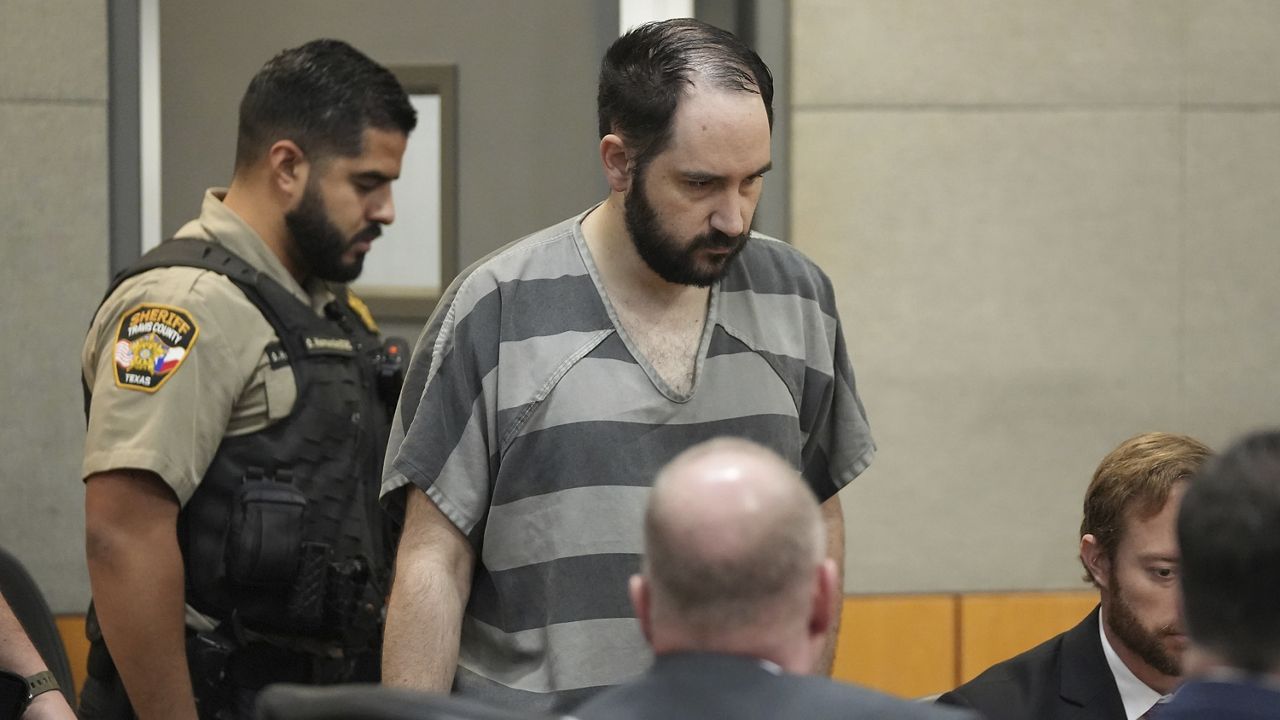World
How Dominican women fight child marriage and teen pregnancy while facing total abortion bans

AZUA, Dominican Republic (AP) — It was a busy Saturday morning at Marcia González’s church. A bishop was visiting, and normally she would have been there helping with logistics, but on this day she was teaching sex education at a local school.
“I coordinate activities at the church and my husband is a deacon,” González said. “The bishop comes once a year and children are being confirmed, but I am here because this is important for my community.”
For 40 years, González and her husband have pushed for broader sex education in the Dominican Republican, one of four Latin American nations that criminalizes abortion without exceptions. Women face up to 2 years in prison for having an abortion; penalties for doctors or midwives range from 5 to 20 years.
With a Bible on its flag, the Caribbean country has a powerful lobby of Catholics and evangelicals who are united against decriminalizing abortion.
President Luis Abinader committed to the decriminalization of abortion as a candidate in 2020, but his government hasn’t acted on that pledge. For now, it depends on whether he is re-elected in May.
To help girls prevent unplanned pregnancies in this context, González and other activists have developed “teenage clubs,” where adolescents learn about sexual and reproductive rights, self-esteem, gender violence, finances and other topics. The goal is to empower future generations of Dominican women.
Outside the clubs, sex education is often insufficient, according to activists. Close to 30% of adolescents don’t have access to contraception. High poverty levels increase the risks of facing an unwanted pregnancy.
For the teenagers she mentors, González’s concerns also go beyond the impossibility of terminating a pregnancy.
According to activists, poverty forces some Dominican mothers to marry their 14 or 15-year-old daughters to men up to 50 years older. Nearly 7 out of 10 women suffer from gender violence such as incest, and families often remain silent regarding sexual abuse.
For every 1,000 adolescents between 15 and 19, 42 became mothers in 2023, according to the United Nations Population Fund. And until 2019, when UNICEF published its latest report on child marriage, more than a third of Dominican women married or entered a free union before turning 18.
Dominican laws have prohibited child marriage since 2021, but community leaders say that such unions are still common because the practice has been normalized and few people are aware of the statute.
“In my 14-year-old granddaughter’s class, two of her younger friends are already married,” González said. “Many mothers give the responsibility of their younger children to their older daughters so, instead of taking care of little boys, they run away with a husband.”
Activists hope education can help prevent girls from facing this situation.
“There are myths that people tell you when you have your period,” said Gabriela Díaz, 16, during a recent encounter organized by the Women’s Equality Center. “They say that we are dirty or we have dirty blood, but that is false. We are helping our body to clean itself and improve its functions.”
Díaz calls González “godmother,” a term applied by Plan International to community leaders who implement the programs of this UK-based organization, which promotes children’s rights.
According to its own data, San Cristóbal and Azua, where González lives, are the Dominican cities with the highest rates of teenage pregnancy and child marriage.
To address this, its clubs accept girls between 13 and 17. Each group meets 2 hours per week, welcomes up to 25 participants and is led by volunteers like González.
In San Cristobal, also in southern Dominican Republic, the National Confederation of Rural Women (CONAMUCA) sponsors teenage clubs of its own.
“CONAMUCA was born to fight for land ownership, but the landscape has changed, and we have integrated new issues, such as food sovereignty, agrarian reform, and sexual and reproductive rights,” said Lidia Ferrer, one of its leaders.
Its clubs gather 1,600 girls in 60 communities, Ferrer said. The topics they study vary from region to region, but among the recurring ones are adolescent pregnancy, early unions and feminicide.
“The starting point is our own reality,” said Kathy Cabrera, who joined CONAMUCA clubs at age 9 and two decades later takes new generations under her wing. “It’s how we live and suffer.”
Migration is increasingly noticeable in rural areas, Cabrera said. Women are forced to walk for miles to attend school or find water, and health services fail in guaranteeing their sexual and reproductive rights.
“We have a government that tells you ’Don’t have an abortion’ but does not provide the necessary contraception to avoid it.”
She has witnessed how 13-year-old girls bear the children of 65-year-old men while neither families nor authorities seem to be concerned. On other occasions, she said, parents “give away” their daughters because they cannot support them or because they discover that they are no longer virgins.
“It’s not regarded as sexual abuse because, if my grandmother got pregnant and married at an early age, and my great-grandmother too and my mother too, then it means I should too,” Cabrera said.
In southern Dominican communities, most girls can relate to this, or know someone who does.
“My sister got pregnant at 16 and that was very disturbing,” said 14-year-old Laura Pérez. “She got together with a person much older than her, and they have a baby. I don’t think that was right.”
The clubs’ dynamics change as needed to create safe and loving environments for girls to share what they feel. Some sessions kick off with relaxation exercises and others with games.
Some girls speak proudly of what they have learned. One of them mentioned she confronted her father when he said she shouldn’t cut any lemons from a tree while menstruating. Another said that her friends always go to the bathroom in groups, to avoid safety risks. They all regard their godmothers as mentors who have their backs.
“They call me to confide everything,” González said. “I am happy because, in my group, no girl has become pregnant.”
Many girls from teenage clubs have dreams they want to follow. Francesca Montero, 16, would like to become a pediatrician. Perla Infante, 15, a psychologist. Lomelí Arias, 18, a nurse.
“I want to be a soldier!” shouted Laura Pérez, the 14-year-old who wants to be careful not to following her sister’s footsteps.
“I was undecided, but when I entered CONAMUCA I knew I wanted to become a soldier. In here we see all these women who give you strength, who are like you, but as a guide,” Pérez said. “It’s like a child seeing an older person and thinking: ’When I grow up, I want to be like that.’”
___
Associated Press religion coverage receives support through the AP’s collaboration with The Conversation US, with funding from Lilly Endowment Inc. The AP is solely responsible for this content.

World
Ukraine's divisive mobilization law comes into force as a new Russian push strains front-line troops
KYIV, Ukraine (AP) — A divisive mobilization law in Ukraine came into force on Saturday, as Kyiv struggles to boost troop numbers after Russia launched a new offensive that some fear could close in on Ukraine’s second-largest city.
The legislation, which was watered down from its original draft, will make it easier to identify every conscript in the country. It also provides incentives to soldiers, such as cash bonuses or money toward buying a house or car, that some analysts say Ukraine cannot afford.
Lawmakers dragged their feet for months and only passed the law in mid-April, a week after Ukraine lowered the age for men who can be drafted from 27 to 25. The measures reflect the growing strain that more than two years of war with Russia has had on Ukraine’s forces, who are trying to hold the front lines in fighting that has sapped the country’s ranks and stores of weapons and ammunition.
Ukrainian President Volodymyr Zelenskyy also signed two other laws Friday, allowing prisoners to join the army and increasing fines for draft dodgers fivefold. Russia enlisted its prisoners early on in the war, and personnel shortages compelled Ukraine to adopt the new measures.
Russian troops, meanwhile, are pushing ahead with a ground offensive that opened a new front in northeastern Ukraine’s Kharkiv region and put further pressure on Kyiv’s overstretched military. After weeks of probing, Moscow launched the new push knowing that Ukraine suffered personnel shortages, and that its forces have been spread thin in the northeast.
Russian President Vladimir Putin said on Friday during a visit to China that the Russian push aims to create “a buffer zone” rather than capturing Kharkiv, the local capital and Ukraine’s second-largest city.
Still, Moscow’s forces have pummeled Kharkiv with strikes in recent weeks, hitting civilian and energy infrastructure and prompting angry accusations from Zelenskyy that the Russian leadership sought to reduce the city to rubble. On Friday, Mayor Ihor Terekhov said that Russian guided bombs killed at least three residents and injured 28 others that day.
Moscow denies deliberately targeting civilians, but thousands have died or suffered injuries in the more than 27 months of fighting.
The U.S. last week announced a new $400 million package of military aid for Ukraine, and President Joe Biden has promised that he would rush badly needed weaponry to the country to help it stave off Russian advances. Still, only small batches of U.S. military aid have started to trickle into the front line, according to Ukrainian military commanders, who said it will take at least two months before supplies meet Kyiv’s needs to hold the line.
Thousands of Ukrainians have fled the country to avoid the draft since Russia’s all-out invasion in February 2022, some risking their lives as they tried to swim across a river separating Ukraine from neighboring Romania and Hungary.
Late on Friday, Ukraine’s border service said that at least 30 people have died trying to cross the Tisza River since the full scale-invasion.
Romanian border guards days earlier retrieved the near-naked, disfigured body of a man that appeared to have been floating in the Tisza for days, and is the 30th known casualty, the Ukrainian agency said in an online statement. It said the man has not yet been identified.
___
Follow AP’s coverage at https://apnews.com/hub/russia-ukraine
World
An unusual autumn freeze grips parts of South America, giving Chile its coldest May in 74 years

Chileans are bundling up for their coldest autumn in more than 70 years mere days after sunning in T-shirts — a dramatic change of wardrobe brought on this week by a sudden cold front gripping portions of South America unaccustomed to bitter wind chills this time of year.
CHILE SHUTS DOWN A POPULAR GLACIER, SPARKING DEBATE OVER CLIMATE CHANGE AND ADVENTURE SPORTS
Temperatures broke records along the coast of Chile and in Santiago, the capital, dipping near freezing and making this month the coldest May that the country has seen since 1950, the Chilean meteorological agency reported.
An unusual succession of polar air masses has moved over southern swaths of the continent, meteorological experts say, pushing the mercury below zero Celsius (32 Fahrenheit) in some places. It’s the latest example of extreme weather in the region — a heat wave now baking Mexico, for instance — which scientists link to climate change.
Footprints create the shape of a heart in a snow-covered rugby field in Santiago, Chile, Wednesday, May 8, 2024. (AP Photo/Matias Basualdo)
“The past few days have been one of the longest (cold fronts) ever recorded and one of the earliest ever recorded” before the onset of winter in the Southern Hemisphere, said Raul Cordero, a climatologist at Santiago University. “Typically the incursions of cold air from the Antarctic that drive temperatures below zero occur from June onwards, not so much in May.”
The cold front sweeping in from Antartica has collided with warm air pushing in from the northwestern Amazon, helping fuel heavy rainstorms battering Brazil, according to that country’s National Meteorological system.
Chile’s government issued frosty weather alerts for most of the country and ramped up assistance for homeless people struggling to endure the frigid temperatures on the streets. Snow cloaked the peaks of the Andes and fell in parts of Santiago, leading to power outages in many areas this week.
“Winter came early,” said Mercedes Aguayo, a street vendor hawking gloves and hats in Santiago.
She said she was glad for a boost in business after Chile’s record winter heat wave last year, which experts pinned on climate change as well as the cyclical El Niño weather pattern.
“We had stored these goods (hats and gloves) for four years because winters were always more sporadic, one day hot, one day cold,” Aguayo said.
This week’s cold snap also took parts of Argentina and Paraguay by surprise.
Energy demand soared across many parts of Argentina. Distributors cut supplies to dozens of gas stations and industries in several provinces to avoid outages in households, , the country’s main hydrocarbon company, CECHA, said Thursday.
World
Brussels, my love? Transparency over MEPs' side jobs

In this edition, we look at what lawmakers’ extracurricular activities mean for their core role.
This week, we are joined by Sophia Russack, senior researcher from the Centre for European Policy Studies, Petros Fassoulas, secretary general of European Movement International and Anna Nalyvayko, senior project officer from the Wilfried Martens Center.
Panelists debate the ethical questions raised by MEPs who have side jobs. Those extra roles are legal, but the political earthquake caused by the Qatarargate scandal led to tighter rules and more transparency.
Is this enough to bridge the gulf between citizens and politicians, in today’s fractured political landscape?
“We see that they have improved rules when it comes to reporting requirements, to laying open your financial situation before and after the offers, and so on. But to be honest, none of these things will prevent another Qatargate,” said Sophia Russack, a think tanker who is an expert in EU institutional architecture, decision-making processes and institutional reform.
Despite these concerns, Petros Fassoulas said MEPs shouldn’t abandon contact with the real world altogether.
“It’s important for them to have the opportunity to bring expertise from outside and engage also with the world outside of the chamber,” Fassoulas said. “An MEP or any parliamentarian should be in contact with the people that they regulate, the businesses that they have an impact on.”
Guests also discussed the reasons for the crisis of public confidence in politicians, and gave some ideas for solutions.
Watch “Brussels, my love?” in the player above.
-

 World1 week ago
World1 week agoPentagon chief confirms US pause on weapons shipment to Israel
-

 Politics1 week ago
Politics1 week agoRFK Jr said a worm ate part of his brain and died in his head
-

 Politics1 week ago
Politics1 week agoOhio AG defends letter warning 'woke' masked anti-Israel protesters they face prison time: 'We have a society'
-

 News1 week ago
News1 week agoNine Things We Learned From TikTok’s Lawsuit Against The US Government
-

 Politics1 week ago
Politics1 week agoBiden’s decision to pull Israel weapons shipment kept quiet until after Holocaust remembrance address: report
-

 Education1 week ago
Education1 week agoVideo: Police Use Pepper Spray on Protesters on G.W.U.’s Campus
-

 World1 week ago
World1 week agoA look at Chinese investment within Hungary
-

 News1 week ago
News1 week agoThe Major Supreme Court Cases of 2024
















